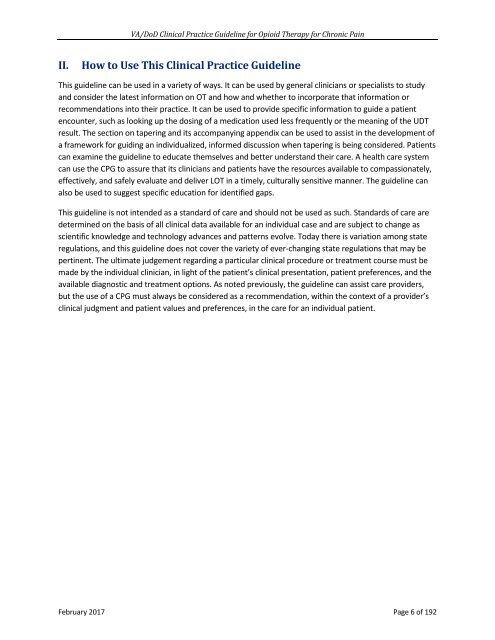VA/DoD CLINICAL PRACTICE GUIDELINE FOR OPIOID THERAPY FOR CHRONIC PAIN
2lfFhbO
2lfFhbO
Create successful ePaper yourself
Turn your PDF publications into a flip-book with our unique Google optimized e-Paper software.
<strong>VA</strong>/<strong>DoD</strong> Clinical Practice Guideline for Opioid Therapy for Chronic Pain<br />
II.<br />
How to Use This Clinical Practice Guideline<br />
This guideline can be used in a variety of ways. It can be used by general clinicians or specialists to study<br />
and consider the latest information on OT and how and whether to incorporate that information or<br />
recommendations into their practice. It can be used to provide specific information to guide a patient<br />
encounter, such as looking up the dosing of a medication used less frequently or the meaning of the UDT<br />
result. The section on tapering and its accompanying appendix can be used to assist in the development of<br />
a framework for guiding an individualized, informed discussion when tapering is being considered. Patients<br />
can examine the guideline to educate themselves and better understand their care. A health care system<br />
can use the CPG to assure that its clinicians and patients have the resources available to compassionately,<br />
effectively, and safely evaluate and deliver LOT in a timely, culturally sensitive manner. The guideline can<br />
also be used to suggest specific education for identified gaps.<br />
This guideline is not intended as a standard of care and should not be used as such. Standards of care are<br />
determined on the basis of all clinical data available for an individual case and are subject to change as<br />
scientific knowledge and technology advances and patterns evolve. Today there is variation among state<br />
regulations, and this guideline does not cover the variety of ever-changing state regulations that may be<br />
pertinent. The ultimate judgement regarding a particular clinical procedure or treatment course must be<br />
made by the individual clinician, in light of the patient’s clinical presentation, patient preferences, and the<br />
available diagnostic and treatment options. As noted previously, the guideline can assist care providers,<br />
but the use of a CPG must always be considered as a recommendation, within the context of a provider’s<br />
clinical judgment and patient values and preferences, in the care for an individual patient.<br />
February 2017 Page 6 of 192


